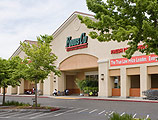Drought: (noun) 1. A prolonged period of abnormally low rainfall, leading to a shortage of water
Despite our spectacular rainy season thus far, California fits within the first half of the definition of a drought: We are in a prolonged period of abnormally low rainfall. But what about our shortage of water? Is it that critical? Must water must be rationed? Should we be fined for showering alone? Not in San Francisco.
Statewide, California’s water reserves are low: Our reservoirs are collectively at 43 percent of their total capacity. But beyond scaring water consumers into rationing, statewide numbers aren’t all that useful because California doesn’t have a single unified water system. Rather we have six separate but interconnected major water systems and literally scores of smaller ones. In fact, we have over 1500 reservoirs in the state. These systems do cooperate with one another—a small ocean is annually shipped from northern to southern California—but no governmental authority exists to compel, say, Marin County to pipe its excess water (its reservoirs are 93 percent full today) to the Isabella reservoir in Kern County which stands at only 10 percent.
Our six major water systems are unique, each at least somewhat dependent on local rainfall and each with its own issues. But they do have certain traits in common, principally the hoarding of water. According to the Pacific Institute, a non-profit devoted to solving the world’s water problems, our largest suppliers of urban water persistently over-estimate their users’ future water demands. Why? Engineers would tell you that the water mavens are using bad data: old numbers that reflect wasteful consumption patterns from decades past and population growth projections that are too robust. Cynics would simply say that’s what bureaucrats do: They cling tenaciously to whatever it is they should be distributing, be it tax refunds, insurance proceeds or water.
That brings us to San Francisco’s water system—the Tuolumne River/Hetch Hetchy System of ten reservoirs. Peter Drekmeier, former Palo Alto mayor and policy director of the Tuolumne River Trust, explains that when this system is at peak capacity, San Francisco has six years’ worth of water without needing to ration a single drop. This bears repeating: Once our dams are topped off, we have a six year water supply. Climatologists know from tree ring measurements that, in the past 1100 years, California has never gone six years without rain. And today, despite two consecutive drought years, the Hetch Hetchy System is already back to 76.1 percent of its total capacity, meaning San Francisco has roughly a 4 ½ year supply of water with no need of rationing.
Yet the San Francisco Public Utilities Commission (SFPUC), the agency that regulates our water still wants to impose rationing and is resisting state efforts to increase the Tuolumne’s unimpaired flow for the benefit of riparian flora and fauna, notably our wild salmon. The SFPUC justifies its parsimony in two ways: first, it inflates future water demand projections despite the fact that, thanks to widely adopted conservation efforts, San Francisco’s customers are using thirty percent less water than they did thirty-five years ago; second, according to Drekmeier, the agency bases its rationing requirements on a theoretical drought scenario that hasn’t occurred in measurable history, an 8.5 year mega-drought comprised of the worst drought we’ve ever had(the 6 years from 1987 through 1992) plus the two driest years on record (1976-77). Figures don’t lie, but assumptions do.
But what’s wrong with keeping every bucketful behind a dam? Isn’t stored water money in the bank? Yes and no. To oversimplify this: Our reservoirs can’t be near capacity during the rainy season; until July 1 st of each year, they need sufficient remaining capacity to accept new rains and snowmelt without fear of flooding. And since we have a wildly outsized rainy season every four or five years, this means that the thrifty water agencies must wrench open the flood gates and do a massive water dump in that fourth or fifth year. Drekmeier insists that we would all be far better off—especially the Tuolumne’s riparian dependents—if the SFPUC used realistic rainfall and usage numbers and released more water on a consistent basis.
An analogy to business is imperfect, but it might illustrate the point. If you’re too cautious in deal-making—if you lard every pro-forma with nightmare contingencies—your new projects will never pencil out and you’re out of business. If we’re too cautious with water, if we hold it back against an eternity of dry days, we’re also out of business. We hand those who would stop development a rallying cry—“How can you propose another subdivision when there isn’t enough water for our existing residents?” And, worse, we seriously threaten the flora and fauna downstream from our reservoirs.
Come to think of it, water is a bit like money: Rather than hoard it, far better to spread water around and do some good with it.






















